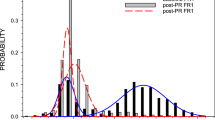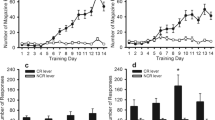Abstract
The effects of amphetamine administration on the partial reinforcement extinction effect (PREE) at one trial a day, were examined. Two groups of rats were trained to run in a straight alley. The continuously reinforced (CRF) group received food reward on every trial. The partially reinforced (PRF) group was rewarded on a quasirandom 50% schedule. All animals were then tested inextinction. dl-Amphetamine 1.5 mg/kg was administered in a 2×2 design, i.e., drug-no drug in acquisition and drug-no drug in extinction. The PREE, i.e., increased resistance to extinction exhibited by PRF animals as compared to CRF animals, was obtained in animals that received saline in acquisition, independently of drug treatment in extinction. In contrast, amphetamine administered in acquisition abolished the PREE irrespective of drug treatment in extinction. In addition, amphetamine administered in extinction alone increased resistance to extinction in PRF animals.
Similar content being viewed by others
References
Amsel A (1958) The role of frustrative nonreward in noncontinuous reward situations. Psychol Bull 55:102–119
Amsel A (1962) Frustrative nonreward in partial reinforcement and discrimination learning. Psychol Rev 69:306–328
Capaldi ES (1966) Partial reinforcement: a hypothesis of sequential effects. Psychol Rev 73:459–477
Capaldi EJ (1967) A sequential hypothesis of instrumental learning. In: Spence KW, Spence JT (eds) The psychology of learning and motivation, vol 1. Academic Press, New York, pp 67–156
Dudderidge HJ, Gray JA (1974) Joint effects of sodium amylobarbitone and amphetamine sulphate on resistance to extinction of a rewarded running response in the rat. Psychopharmacology 35:35–370
Feldon J, Gray JA (1979a) Effects of medial and laterial septal lesions on the partial reinforcement extinction effect at one trial a day. Q J Exp Psychol 31:653–674
Feldon J, Gray JA (1979b) Effects of medial and lateral septal lesions on the partial reinforcement extinction effect at short inter-trial intervals. Q J Exp Psychol 31:675–690
Feldon J, Gray JA (1981) The partial reinforcement extinction effect after treatment with chlordiazepoxide. Psychopharmacology 73:269–275
Gomer FE, Jakubczak LF (1974) Dose-dependent selective facilitation of response-contingent light-onset behavior by d-amphetamine. Psychopharmacologia 34:199–208
Gray JA (1975) Elements of a two-process theory of learning. Academic Press, London
Henke PJ (1974) Persistence of runway performance after septal lesions in rats. J Comp Physiol Psychol 86:760–767
Heise GA, Milar KS (1984) Drugs and stimulus control. In: Iversen LL, Iversen SD, Snyder SH (eds) Handbook of Psychopharmacology, vol 18. Plenum Press, New York, pp 129–190
Hill RT (1970) Facilitation of conditioned reinforcement as a mechanism of psychomotor stimulation. In: Costa E, Garattini S (eds) Amphetamine and related compounds. Raven Press, New York, pp 781–795
Ksir C (1975) Scopolamine and amphetamine effects on discrimination: interaction with stimulus control. Psychopharmacologia 43:37–41
Ksir C, Sleifer B (1982) Drug effects on discrimination at two levels of stimulus control. Psychopharmacology 76:286–290
Kulig BM, Calhoun WH (1972) Enhancement of successive discrimination reversal learning by methamphetamine. Psychopharmacology 27:233–240
Laties VG, Wood RW, Rees DC (1981) Stimulus control and the effects of d-amphetamine in the rat. Psychopharmacology 75:277–282
Lubow RE (1973) Latent inhibition. Psychol Bull 79:398–407
Lyon M, Robbins TW (1975) The action of central nervous system stimulant drugs: a general theory concerning amphetamine effects. In: Essman WB, Valzelli L (eds) Current developments in psychopharmacology, vol 2. Spectrum, New York, pp 79–163
Mackintosh NJ (1974) The psychology of animal learning. London, Academic Press
Overton DA (1968) Dissociated learning in drug states (state-dependent learning). In: Efron DH, Cole JO, Levine J, Wittenborn R (eds) Psychopharmacology: A review of progress. PHS Publication 1836, United States Government Office Washington DC, pp 918–930
Rashotte ME (1979) Reward training: extinction. In: Bitterman ME, Lolordo VM, Overmier JB, Rashotte ME (eds) Animal Learning, Plenum Press, New York, pp 241–278
Rawlins JNP, Feldon J, Gray JA (1980) The effects of hippocampectomy and of fimbria section upon the partial reinforcement extinction effect in rats. Exp Brain Res 38:273–283
Ridley RM, Haystead TAJ, Baker HF (1981) An analysis of visual object reversal learning in the marmoset after amphetamine and heloperidol. Pharmacol Biochem Behav 14:345–351
Robbins TW, Sahakian BJ (1983) Behavioral effects of psychomotor stimulant drugs: clinical and neuropsychological implications. In: Creese I (ed) Stimulants: neurochemical, behavioral and clinical perspectives. Raven Press, New York, pp 301–338
Robbins TW, Watson BA, Gaskin M, Ennis C (1983) Contrasting interactions of pipradol, d-amphetamine, cocaine, cocaine analogues, apomorphine and other drugs with conditioned reinforcement. Psychopharmacology 80:113–119
Sanger DJ, Blackman DE (1976) Rate-dependent effects of drugs: a review of the literature. Pharmacol Biochem Behav 4:73–83
Stein L (1964) Self-stimulation of the brain and the central stimulant action of amphetamine. Fed Proc 23:836–850
Weiner I, Lubow RE, Feldon J (1981) Chronic amphetamine and latent inhibition. Behav Brain Res 2:285–286
Weiner I, Lubow RE, Feldon J (1984) Abolition of the expression but not the acquisition of latent inhibition by chronic amphetamine in rats. Psychopharmacology 83:194–199
Weiss B, Laties VG (1971) Reconciling the effects of amphetamine on human and animal behavior. Proceedings of the European Society for the study of drug toxicity V. XII
Author information
Authors and Affiliations
Rights and permissions
About this article
Cite this article
Weiner, I., Bercovitz, H., Lubow, R.E. et al. The abolition of the partial reinforcement extinction effect (PREE) by amphetamine. Psychopharmacology 86, 318–323 (1985). https://doi.org/10.1007/BF00432221
Issue Date:
DOI: https://doi.org/10.1007/BF00432221




